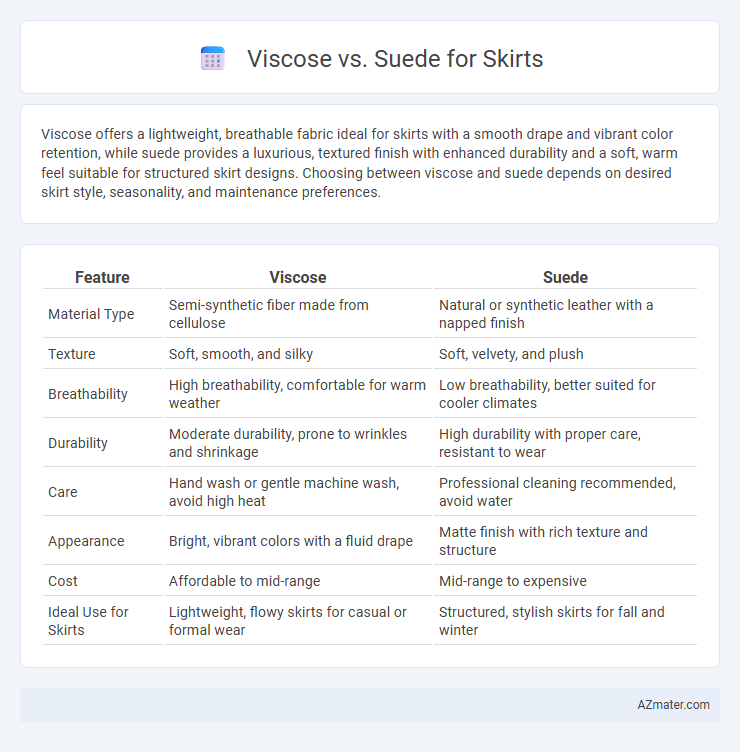Viscose offers a lightweight, breathable fabric ideal for skirts with a smooth drape and vibrant color retention, while suede provides a luxurious, textured finish with enhanced durability and a soft, warm feel suitable for structured skirt designs. Choosing between viscose and suede depends on desired skirt style, seasonality, and maintenance preferences.
Table of Comparison
| Feature | Viscose | Suede |
|---|---|---|
| Material Type | Semi-synthetic fiber made from cellulose | Natural or synthetic leather with a napped finish |
| Texture | Soft, smooth, and silky | Soft, velvety, and plush |
| Breathability | High breathability, comfortable for warm weather | Low breathability, better suited for cooler climates |
| Durability | Moderate durability, prone to wrinkles and shrinkage | High durability with proper care, resistant to wear |
| Care | Hand wash or gentle machine wash, avoid high heat | Professional cleaning recommended, avoid water |
| Appearance | Bright, vibrant colors with a fluid drape | Matte finish with rich texture and structure |
| Cost | Affordable to mid-range | Mid-range to expensive |
| Ideal Use for Skirts | Lightweight, flowy skirts for casual or formal wear | Structured, stylish skirts for fall and winter |
Introduction to Viscose and Suede
Viscose is a semi-synthetic fiber derived from natural cellulose, known for its smooth texture, breathability, and silk-like appearance, making it a popular choice for lightweight skirts. Suede, a type of leather with a napped finish, offers a soft, velvety surface and durability, adding a luxurious and tactile element to skirts. Both materials provide distinct aesthetic and functional qualities, influencing skirt style, comfort, and seasonality.
Key Characteristics of Viscose
Viscose fabric is known for its silk-like softness, breathability, and excellent drape, making it ideal for skirts that require fluid movement and comfort. It is lightweight, moisture-absorbent, and hypoallergenic, which enhances wearability in warm weather. Viscose also retains vivid colors well, ensuring skirts remain vibrant after multiple washes.
Key Characteristics of Suede
Suede is a type of leather with a soft, napped finish created from the underside of animal hides, offering a luxurious texture that contrasts with the smoothness of viscose fabric. Its key characteristics include durability, breathability, and a distinctive matte appearance that enhances the aesthetic appeal of skirts. Suede skirts provide warmth and a structured fit, making them ideal for cooler seasons and sophisticated styling.
Texture and Feel Comparison
Viscose skirts offer a smooth, silky texture with a lightweight and breathable feel, making them ideal for comfort and drape. Suede skirts provide a soft, velvety surface with a thicker, more structured touch, often conveying a luxurious and warm sensation. The choice between viscose and suede hinges on the desired texture--sleek and flowing versus rich and tactile.
Breathability and Comfort
Viscose skirts offer excellent breathability due to their natural cellulose fibers, making them ideal for warm weather as they wick moisture away from the skin. Suede skirts, made from animal hide, provide a soft texture but lack breathability, often causing discomfort in hotter climates. Choosing viscose enhances comfort through better airflow, while suede suits cooler environments where insulation is preferred.
Durability and Maintenance
Viscose skirts offer moderate durability but require delicate care, such as hand washing or dry cleaning, to prevent damage and maintain fabric integrity. Suede skirts provide higher durability due to their thick, textured surface, yet they demand special maintenance like professional cleaning and waterproofing to avoid stains and wear. Selecting between viscose and suede depends on balancing the need for softness and breathability against long-term resilience and upkeep.
Style and Appearance Differences
Viscose skirts offer a smooth, lightweight drape with a subtle sheen that enhances fluidity and softness, making them ideal for elegant and flowy styles. Suede skirts present a matte, textured surface with a structured silhouette, adding a rich, luxurious, and slightly rugged appearance perfect for autumn or winter fashion. The contrast between viscose's glossy smoothness and suede's velvety depth creates distinctly different style statements suitable for varied seasonal wardrobes.
Suitability for Various Climates
Viscose is a breathable, lightweight fabric that excels in warm and humid climates, providing comfort and moisture absorption for skirts. Suede, made from animal hide with a napped finish, offers better insulation and durability, making it suitable for cooler, drier environments. Choosing between viscose and suede skirts depends on the climate's temperature and humidity, with viscose ideal for hot weather and suede preferred for cold conditions.
Sustainability and Environmental Impact
Viscose skirts are derived from wood pulp, making them semi-synthetic but often linked to deforestation and chemical-intensive processing that can harm ecosystems. Suede skirts, typically made from animal hides, involve leather tanning processes that generate significant water pollution and greenhouse gas emissions. Choosing sustainable skirt materials involves considering the environmental costs of viscose production and the animal welfare and chemical impacts associated with suede.
Choosing the Right Fabric for Your Skirt
Viscose fabric offers a lightweight, breathable option with a smooth texture, ideal for skirts that require fluid drape and comfort in warm weather. Suede, a heavier, textured fabric made from animal hide or synthetic alternatives, provides durability and a luxurious appearance suitable for structured skirts and cooler climates. Choosing between viscose and suede depends on desired skirt style, season, and maintenance, with viscose favoring casual, airy designs and suede supporting formal, durable garments.

Infographic: Viscose vs Suede for Skirt
 azmater.com
azmater.com